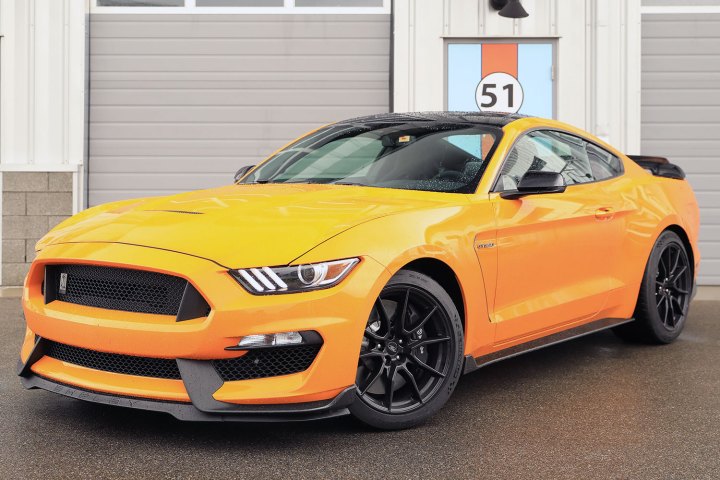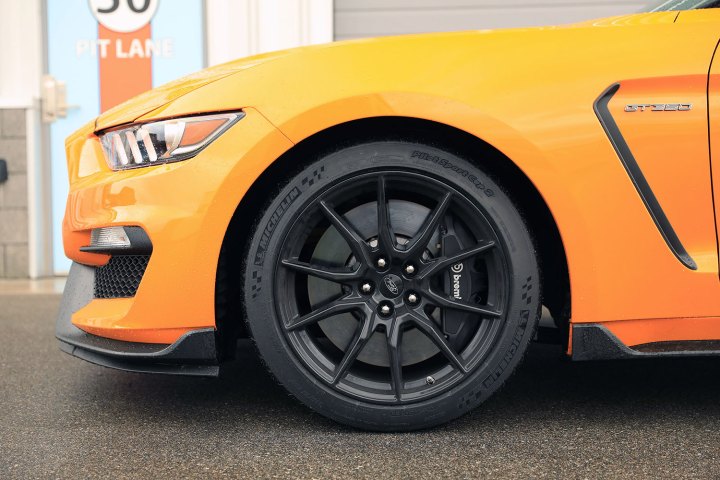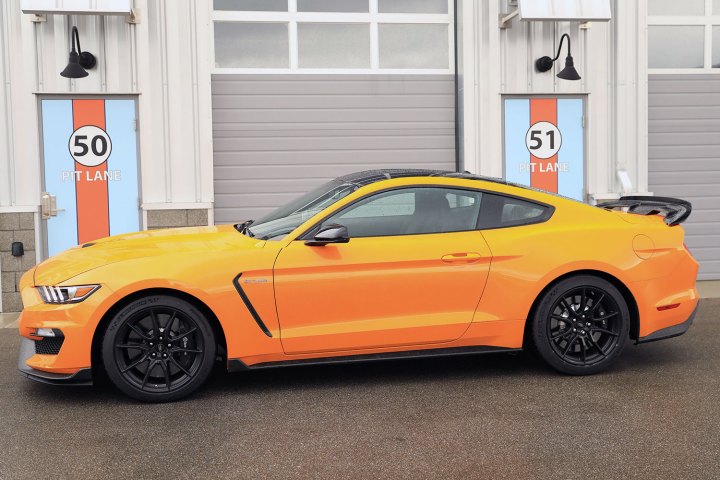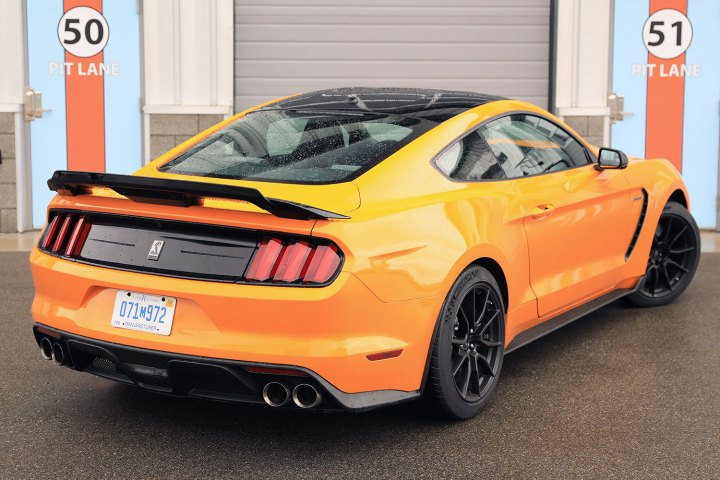“The standard GT350 finally gets the suspension and tire package it deserves.”
- Taut, track-ready suspension
- Tons of grip from new Cup 2 tire
- Flat-plane crank V8 still impresses
- New hardware comes with a higher price tag
- Recaro seats not ideal for longer drives
When the GT350 debuted for the 2016 model year, the centerpiece of the new Shelby was undoubtedly Ford’s new 5.2-liter Voodoo V8. High revving and full of character, the 526 horsepower naturally aspirated mill was a great match for a Mustang designed with track prowess in mind.
But while the limited production GT350R showed just how capable the sixth generation Mustang’s platform could be when dialed in for serious road course performance, the gap between it and the standard GT350 proved to be more sizable than the spec sheet initially suggested, as the latter’s more conservative tire and suspension package, in particular, made the standard Shelby feel more like a garden-variety GT with an engine swap rather than a legitimate track weapon. That discrepancy became even more glaring last year with the introduction of Performance Pack 2, an options package that bestowed the GT with more aggressive handling hardware than the 2018 Shelby GT350 was equipped with.
Keen to bring the Mustang performance hierarchy back in line, Ford has turned their attention to the GT350 once again and bestowed it with some updates for 2019. This update has injected new life into the Shelby, delivering the incredibly surefooted – yet street-friendly – machine that we’ve always hoped it would be.
On the other hand, with a new starting price of $59,140, the GT350 also sees a price hike of more than $3000 for 2019. Is the new Shelby worth the price of admission? We headed to the M1 Concourse, a private track facility in Pontiac, Michigan, to find out.
Inside and out
In years past, the Shelbys differentiated themselves from standard Mustangs largely by their aggressive bodywork and hunkered down stance. But while the rest of the lineup has adopted the aesthetic changes that were part of the Mustang’s 2018 facelift, the Shelby GT350, GT350R, and upcoming GT500 have not. Whether that’s good or bad is largely subjective, but this author considers it a win.
Although most of the visual upgrades that are part of the Shelby GT350 package carry over from 2018, the updated pony car does come with a few notable tweaks. Included is a new rear spoiler with an optional Gurney Flap that improves rear downforce (and thus high-speed stability) while giving the GT350 a more distinctive look. A new set of 19-inch aluminum wheels and the availability of Velocity Blue and Ford Performance Blue paint hues also help the revised Shelby stand out from its predecessors. While it’s not a comprehensive rethink of the GT350’s look, the tweaks do bring the standard Shelby into closer parity with the R-spec model when it comes to curb appeal.
The changes are subtle inside as well. Newly designed door panels, a standard machined aluminum instrument panel appliqué, and a wrapped center console are the most obvious changes, but the Shelby’s handsome, purposeful interior didn’t need much fixing to begin with. Recaro sport seats are outfitted as standard, but new power-adjustable chairs are also available for drivers looking for something with a bit more everyday comfort.
Hardware upgrades
The 2019 Mustang Shelby GT350 now boasts custom-tuned 12-speaker Bang & Olufsen stereo on the options sheet, and Ford’s 8-inch Sync 3 touchscreen infotainment system is now standard, as is dual-zone climate control. But when it comes to vehicles with Carroll Shelby’s name attached to them, the most interesting engineering is typically underneath the skin, and the 2019 GT350 is no exception.
The performance improvements start where the rubber meets the road.
The performance improvements start where the rubber meets the road. Literally. Ford Performance worked with Michelin to develop a new “FP” spec Pilot Sport Cup 2 tire for the GT350 to replace the more street-focused Pilot Super Sport that the Shelby was formerly outfitted with. Not to be confused with the Pilot Sport Cup 2 used on the Shelby GT350R, this new tire has a unique compound and tread pattern that’s designed to be more usable in wet weather while retaining the incredible levels of grip that the Cup 2 is known for.
To complement the new tire and aero bits, Ford also revised the Shelby’s suspension. This includes retuning the adjustable MagneRide dampers, swapping in stiffer front springs, and installing a bigger sway bar in the rear. While the Brembo brake hardware is unchanged, engineers updated the antilock braking software to allow drivers to take full advantage of the additional grip on tap.
Driving impressions
M1’ Concours’s tight, 1.5-mile track doesn’t offer enough room to stretch the Shelby’s legs to a degree that allows you to exploit the additional downforce provided by the new rear spoiler, but it does offer plenty of opportunities to experience the GT350’s newfound handling prowess.
The forecast warned of thunderstorms the morning of our on-track seat time, but by some small miracle the rain hadn’t yet soaked the track when we arrived in the morning. Obviously, we wasted little time getting behind the wheel and out on the course. Within just a few laps the handling improvements were obvious – the retuned suspension gives the car a significantly more buttoned-down feel at speed than it’s had in years past, while the new Cup 2 tire offers a near-endless well of grip. The Shelby remains a row-your-own affair, but you’ll get no complaints from us on that front either, as the slick Tremec six-speed gearbox continues to offer short, positive throws and an intuitive, relatively low-effort clutch.
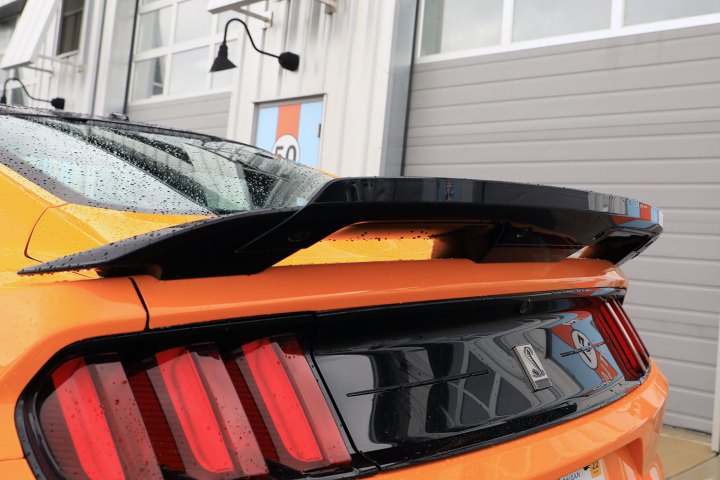
Ford touts the updated Shelby GT350 as a machine that’s rewarding for track veterans but approachable for novices as well. The new Michelin tire corroborates that claim, offering clear communication about the threshold of grip despite being a near-race-spec compound, and staying admirably resistant to overheating despite our occasionally overzealous pace. Along with the oil, differential, and transmission coolers that were made standard in 2017, the new tire compound, revised suspension, and more substantial aero give the GT350 what it needs to inspire confidence behind the wheel and convince would-be drivers to push a little harder with each subsequent lap. With the brakes showing no sign of fade after multiple sessions, that’s exactly what we did.
To complement the new tire and aero bits, Ford also revised the Shelby’s suspension.
While the new GT350 is rewarding on a road course, there was some concern that the more aggressive chassis tuning might translate to an abusive ride on public streets. By mid-day the rain had also finally rolled in, presenting the Shelby with even less ideal road conditions for everyday driving.
Yet despite the crucible that is post-winter Michigan tarmac, the GT350 was admirably composed in Comfort driving mode, with the MagneRide dampers providing enough compliance to make even the most pockmarked streets tolerable. Some drivers might find the Recaro seats to be a bit much in everyday use, but the aggressive shoulder and thigh bolsters pay dividends during high-speed maneuvering, so the decision of whether to opt for those or the cushier power seats largely comes down to a particular driver’s priorities.
Rivals
The Mustang’s decades-long rivalry with the Camaro shows no signs of slowing down. While Chevrolet doesn’t offer a direct competitor to the GT350, the 455 horsepower Camaro SS 1LE ($49,995) and 650 hp supercharged Camaro ZL1 ($62,000) are both models with similar intentions to the Shelby.
Although the Camaro’s chassis is one of the best in the business, its high beltline provides less outward visibility than the Mustang, and the Ford’s interior is noticeably more refined. The Camaro might still be the king of the race track, but the Shelby would likely be easier to live with on a day to day basis than either Camaro model.
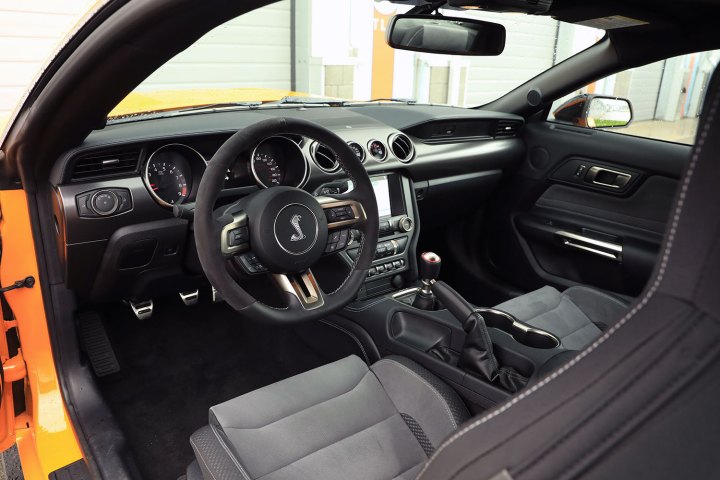
And while it loses a step to both the Ford and Chevy in terms of outright handling capability, Dodge’s Challenger R/T Scat Pack Widebody is no slouch either. Although its larger size makes this muscle car less nimble than its rivals, the Dodge offers significantly more passenger room, cargo space, and overall comfort than either of its rivals.
Peace of mind
Ford offers a three-year, 36,000-mile basic warranty and a five year, 60,000-mile powertrain warranty on the Mustang Shelby GT350. Standard safety features include front, side, overhead, and knee airbags, anti-lock brakes, stability control, and belt pre-tensioners.
How DT would configure this car
To make the Shelby as track-capable as possible while also bolstering its everyday drivability, we’d opt for the Recaro seats and optional Gurney Flap spoiler, but we’d also spring for the Bang & Olufsen audio.
And despite the fact that the Shelby looks great in Ford Performance Blue, we were particularly smitten with our tester’s Orange Fury hue and the contrast it creates with the Shelby’s black accents, so we’d likely go that route if we were building a GT350 for ourselves.
Conclusion
Ford’s efforts to enhance the model’s on-track capability have elevated the fun factor while also avoiding any significant detriments to its everyday drivability. If you’ve been pining for a GT350 but wished it had a bit more of an earnest approach to track capability without the inherent compromises (and price tag) of the GT350R, we’re happy to report that your new Shelby has finally arrived.

